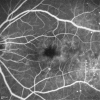Ranibizumab in the Treatment of Diabetic Macular Edema: A Review of the Current Status, Unmet Needs, and Emerging Challenges
- PMID: 28484955
- PMCID: PMC5487872
- DOI: 10.1007/s12325-017-0548-1
Ranibizumab in the Treatment of Diabetic Macular Edema: A Review of the Current Status, Unmet Needs, and Emerging Challenges
Abstract
Diabetic retinopathy (more specifically diabetic macular edema, DME) is the most common cause of loss of vision in the working population in developed countries. Anti-vascular endothelial growth factor (anti-VEGF) agents considerably changed the treatment algorithms and improved prognosis of center-involving DME. Ranibizumab was the first approved anti-VEGF agent that revolutionized DME treatment. The vast increase in the number of patients undergoing intravitreal treatment and the role of anti-VEGF pharmacotherapy as the mainstay of DME treatment have triggered several challenges. Among them, of considerable interest is the quest for an optimal dosing scheme and the search for combination therapies. Although a significant body of research is directed towards other molecules that could potentially be new therapeutic targets, VEGF inhibition is expected to play an important long-term role in the treatment of DME considering the pathogenesis of the disease. Finally, recent studies revealed that ranibizumab may constitute a significant treatment modality in the management of other diabetic vision-threatening complications including proliferative diabetic retinopathy.
Keywords: Anti-VEGF; Diabetic macular edema; Diabetic retinopathy; Macula exudates; Ophthalmology; Ranibizumab.
Figures
Similar articles
-
VEGF-A gene polymorphisms and responses to intravitreal ranibizumab treatment in patients with diabetic macular edema.Int Ophthalmol. 2018 Dec;38(6):2381-2388. doi: 10.1007/s10792-017-0738-5. Epub 2017 Oct 13. Int Ophthalmol. 2018. PMID: 29030794
-
Intravitreal ranibizumab alone or in combination with panretinal photocoagulation for the treatment of proliferative diabetic retinopathy with coexistent macular edema: long-term outcomes of a prospective study.Acta Diabetol. 2020 Oct;57(10):1219-1225. doi: 10.1007/s00592-020-01548-y. Epub 2020 May 29. Acta Diabetol. 2020. PMID: 32472172 Clinical Trial.
-
The efficacy of micropulse laser combined with ranibizumab in diabetic macular edema treatment: study protocol for a randomized controlled trial.Trials. 2022 Sep 2;23(1):736. doi: 10.1186/s13063-022-06593-2. Trials. 2022. PMID: 36056443 Free PMC article.
-
Treatment strategies for refractory diabetic macular edema: switching anti-VEGF treatments, adopting corticosteroid-based treatments, and combination therapy.Expert Opin Biol Ther. 2016;16(3):365-74. doi: 10.1517/14712598.2016.1131265. Epub 2016 Jan 12. Expert Opin Biol Ther. 2016. PMID: 26674182 Review.
-
[Intravitreal ranibizumab in diabetic macular edema].Klin Oczna. 2010;112(10-12):333-6. Klin Oczna. 2010. PMID: 21473086 Review. Polish.
Cited by
-
Drivers of and Barriers to Adherence to Neovascular Age-Related Macular Degeneration and Diabetic Macular Edema Treatment Management Plans: A Multi-National Qualitative Study.Patient Prefer Adherence. 2022 Mar 3;16:587-604. doi: 10.2147/PPA.S347713. eCollection 2022. Patient Prefer Adherence. 2022. PMID: 35264847 Free PMC article.
-
Aflibercept for clinically significant diabetic macular edema: 12-month results in daily clinical practice.Clin Ophthalmol. 2018 Jan 8;12:99-104. doi: 10.2147/OPTH.S154421. eCollection 2018. Clin Ophthalmol. 2018. PMID: 29386883 Free PMC article.
-
Patient Preferences with Anti-Vascular Endothelial Growth Factor Treatment for Neovascular Age-Related Macular Degeneration and Diabetic Macular Edema: A Multinational Discrete Choice Experiment Study.Ophthalmic Res. 2025;68(1):13-22. doi: 10.1159/000541349. Epub 2024 Nov 21. Ophthalmic Res. 2025. PMID: 39571557 Free PMC article.
-
Exploring the Spectrum of VEGF Inhibitors' Toxicities from Systemic to Intra-Vitreal Usage in Medical Practice.Cancers (Basel). 2024 Jan 13;16(2):350. doi: 10.3390/cancers16020350. Cancers (Basel). 2024. PMID: 38254839 Free PMC article. Review.
-
Retinal vein changes after treatment with aflibercept and PRP in high-risk proliferative diabetic retinopathy.Front Med (Lausanne). 2023 Mar 9;10:1090964. doi: 10.3389/fmed.2023.1090964. eCollection 2023. Front Med (Lausanne). 2023. PMID: 36968838 Free PMC article.
References
-
- Control CfD, Prevention. National diabetes statistics report: estimates of diabetes and its burden in the United States, 2014. Atlanta: US Department of Health and Human Services; 2014.
Publication types
MeSH terms
Substances
LinkOut - more resources
Full Text Sources
Other Literature Sources
Medical



